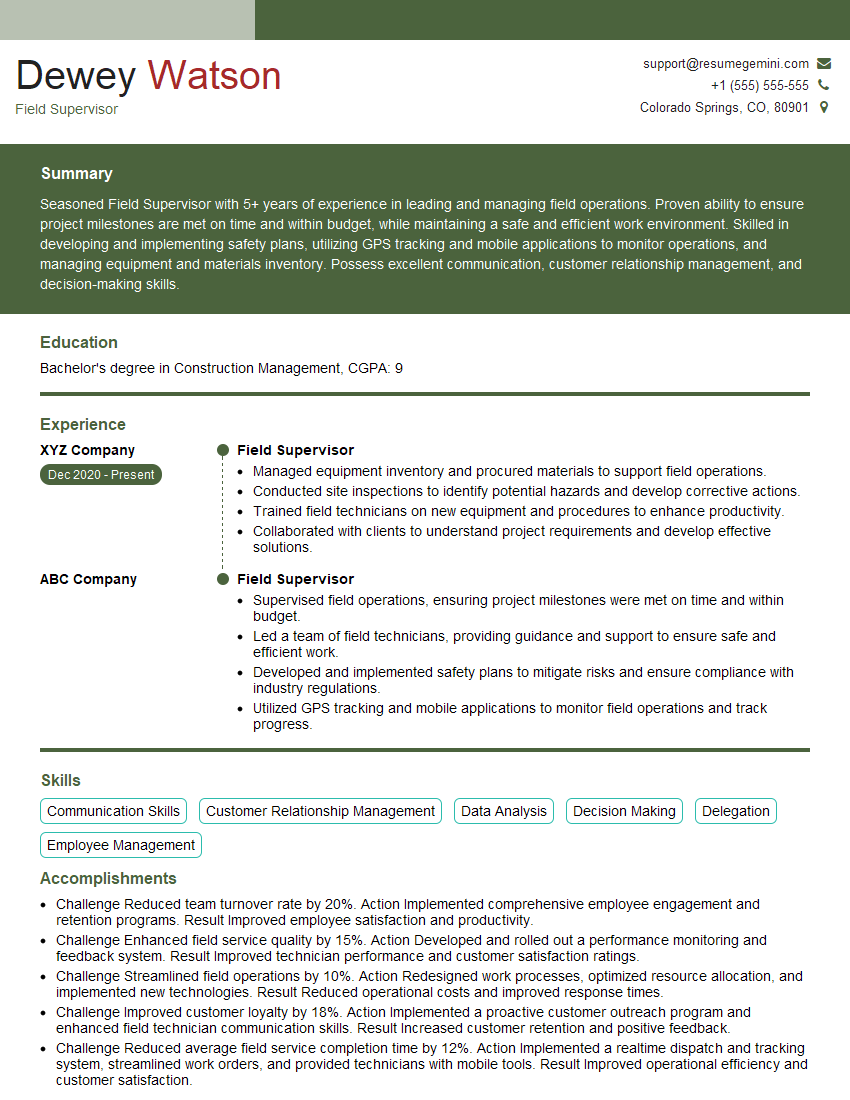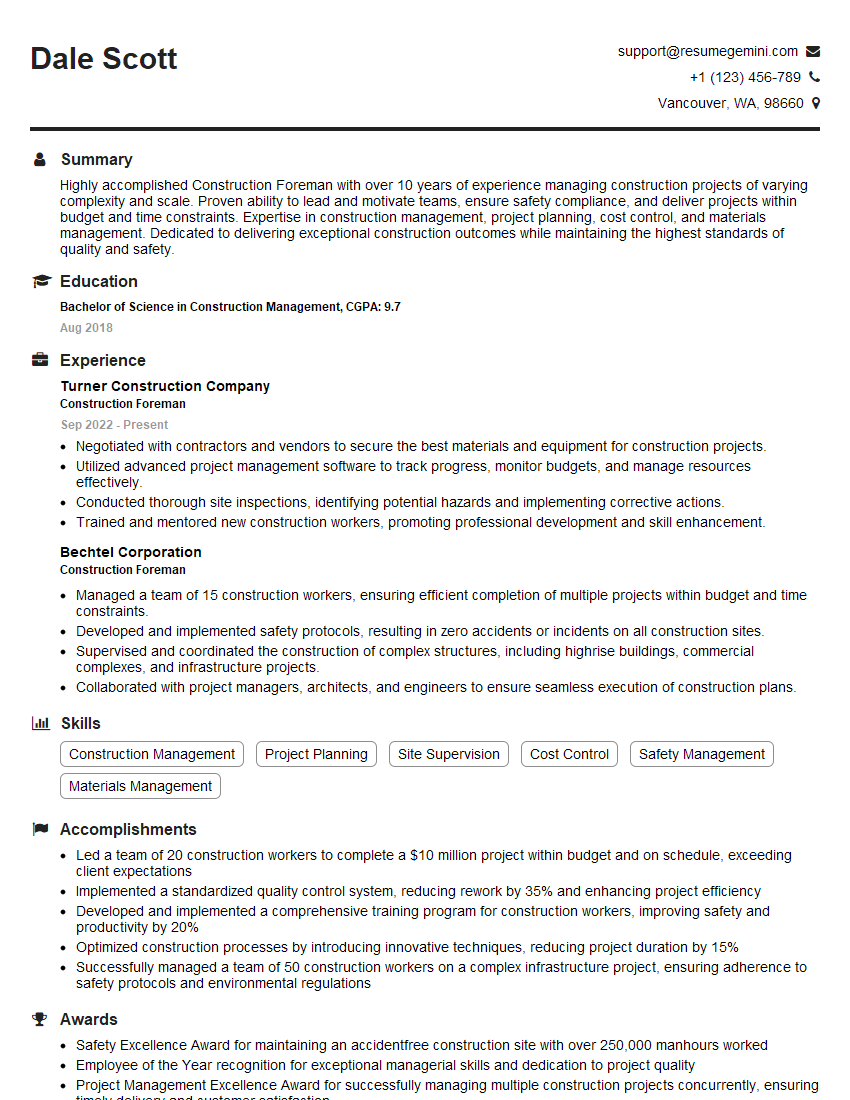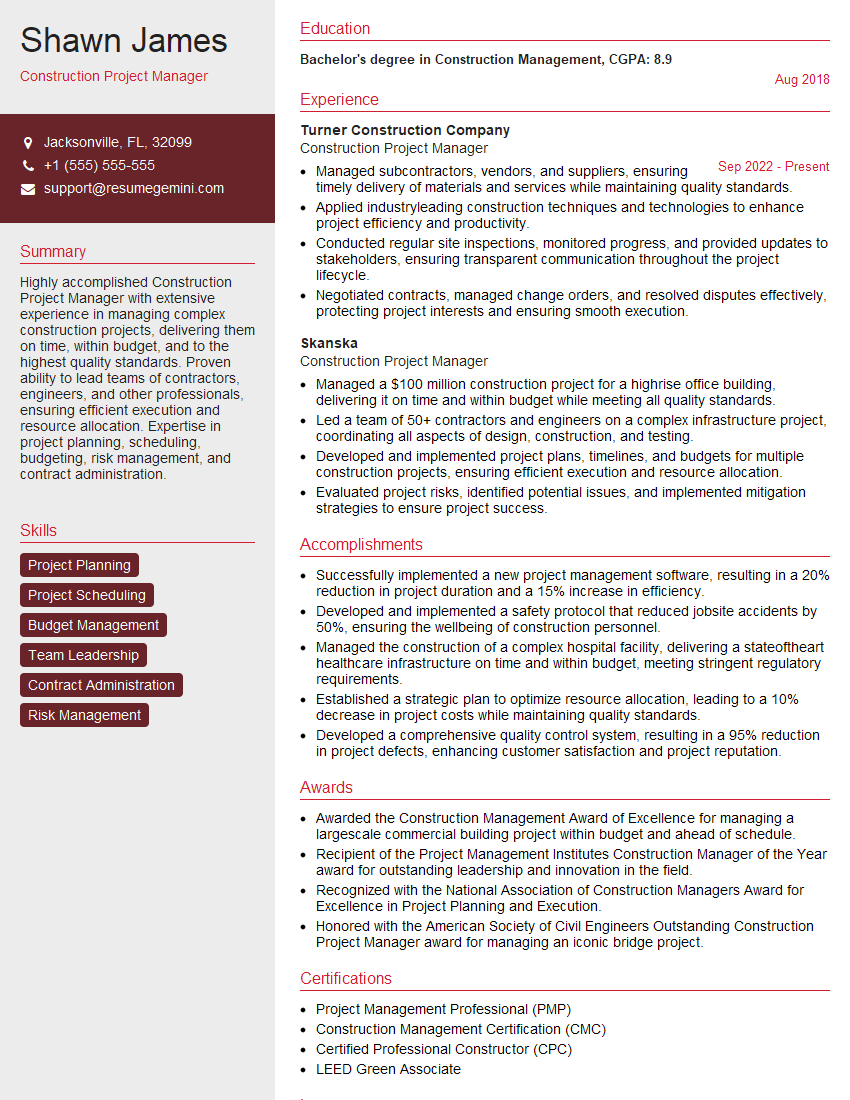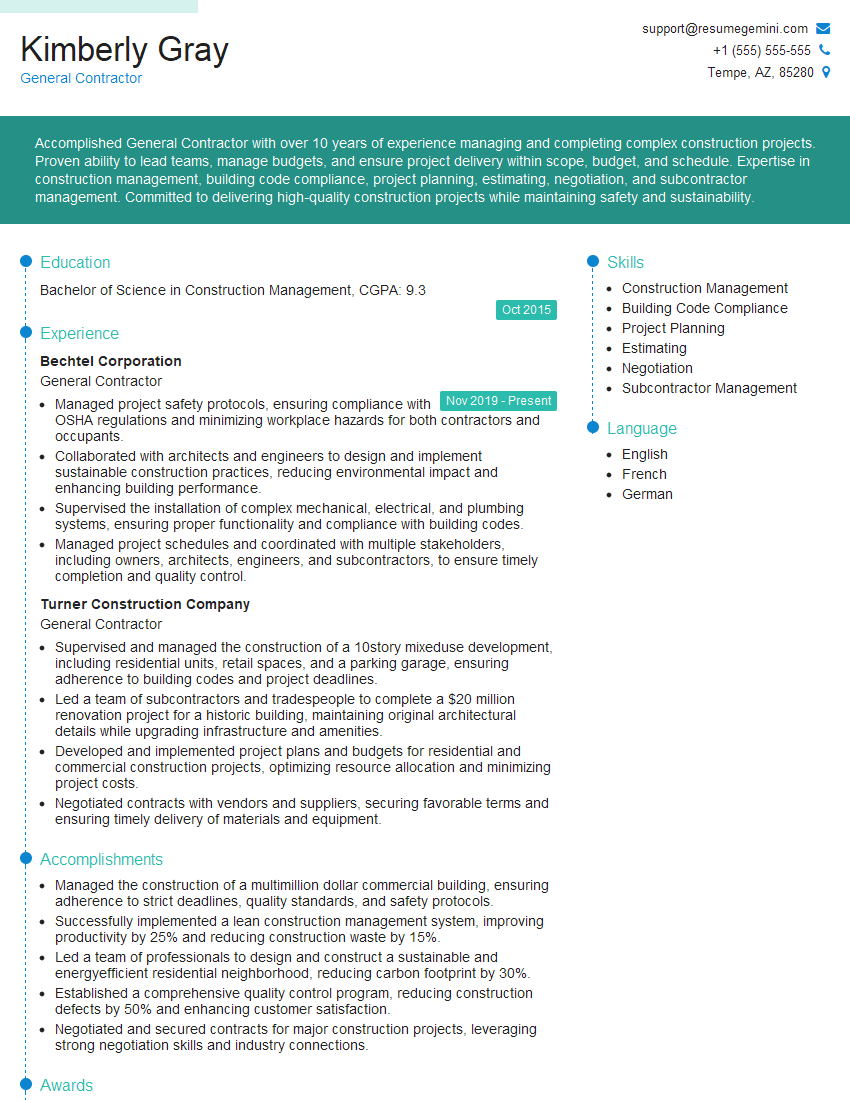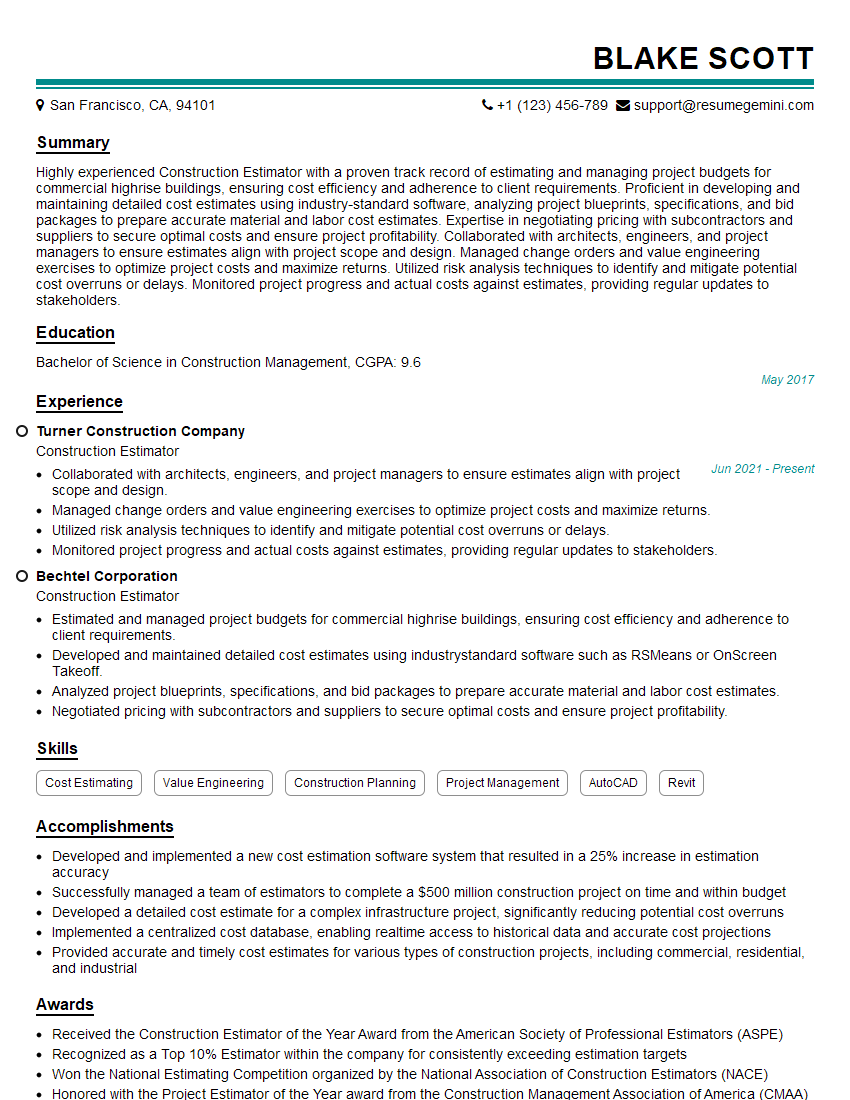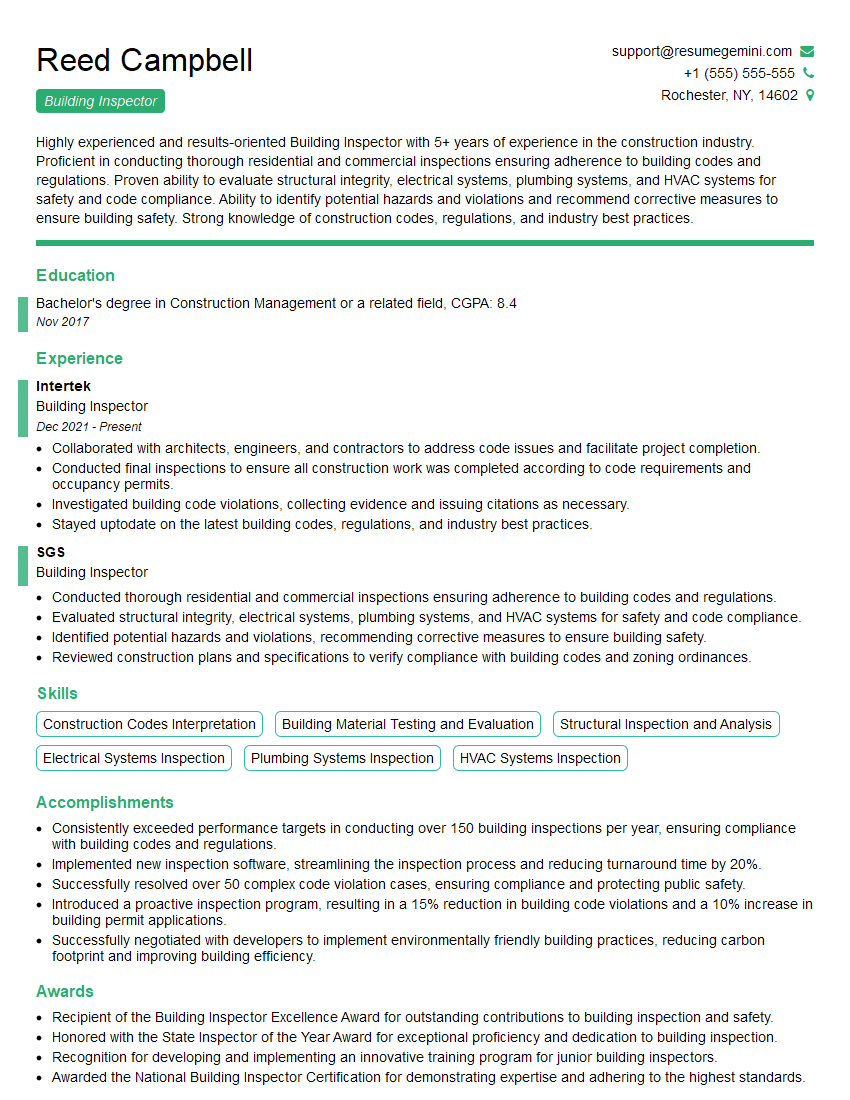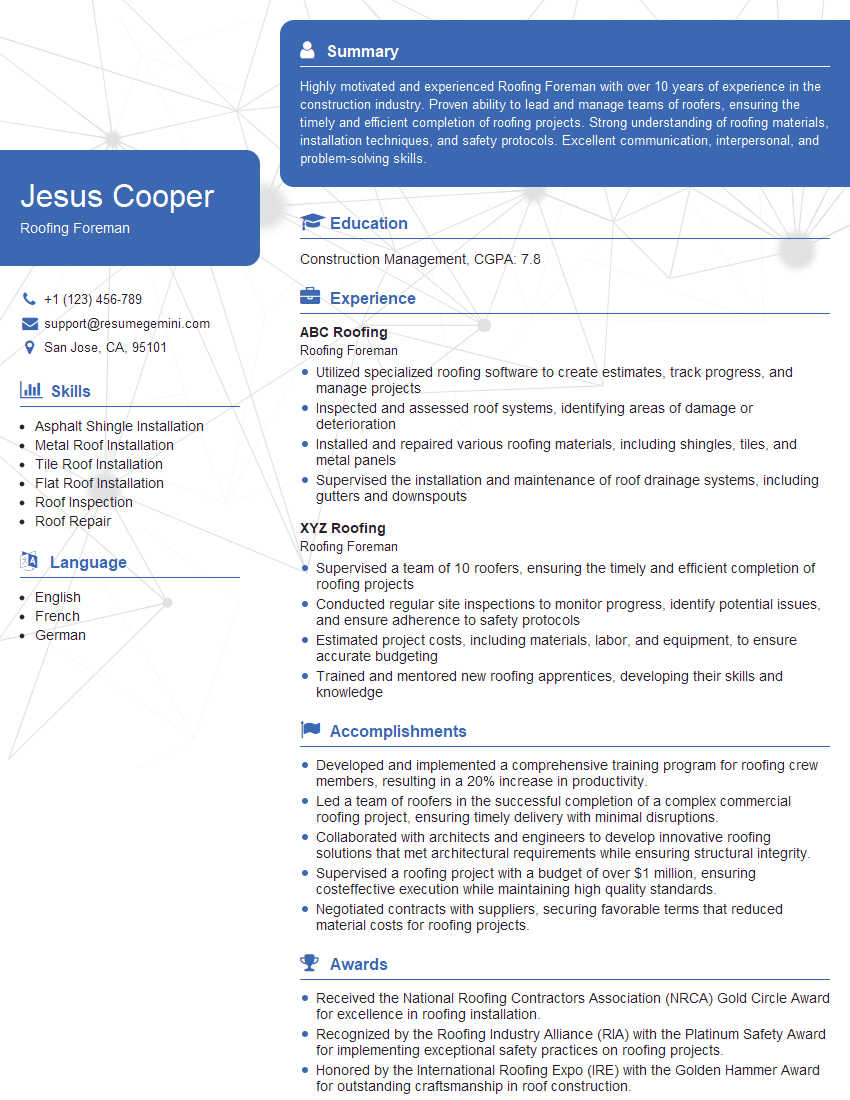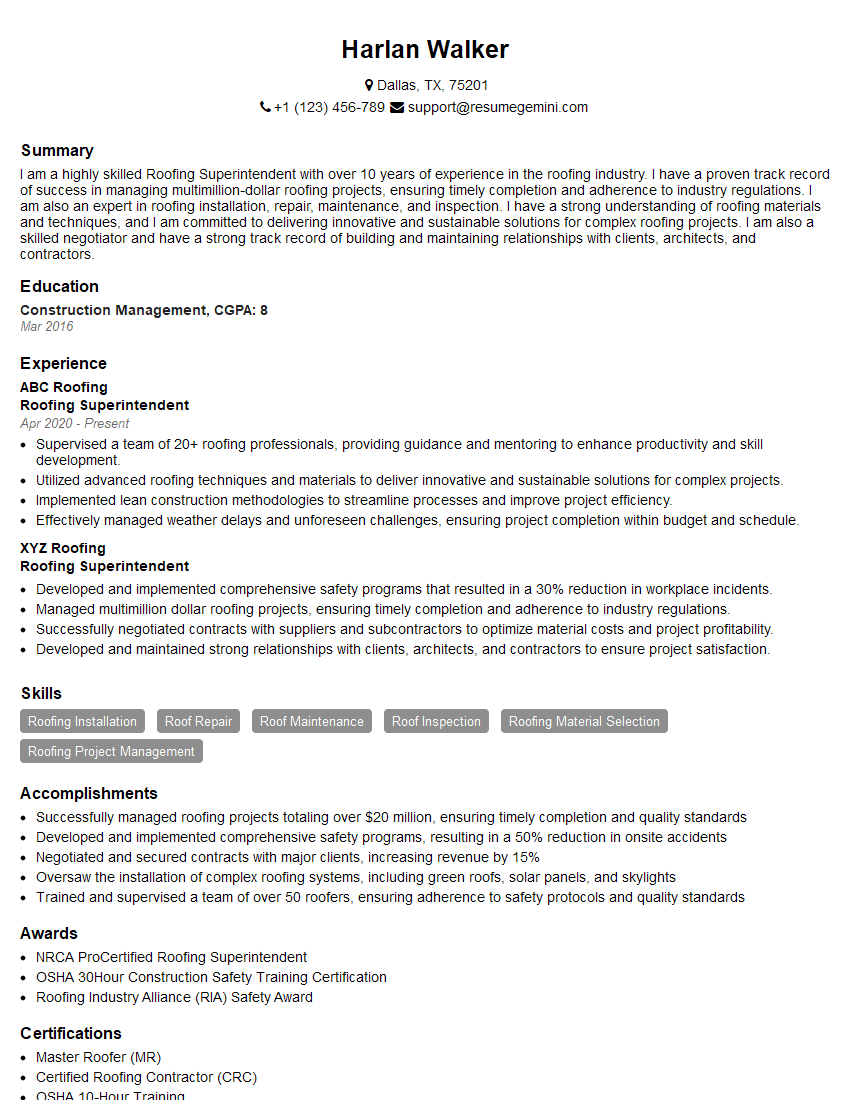Unlock your full potential by mastering the most common Ridge Vent and Shingle Ventilation interview questions. This blog offers a deep dive into the critical topics, ensuring you’re not only prepared to answer but to excel. With these insights, you’ll approach your interview with clarity and confidence.
Questions Asked in Ridge Vent and Shingle Ventilation Interview
Q 1. Explain the importance of proper attic ventilation.
Proper attic ventilation is crucial for the health and longevity of your roof and entire house. Think of your attic as a large, enclosed space that can trap heat, moisture, and other elements. Without adequate ventilation, this trapped air can lead to a variety of problems, from mold and mildew growth to structural damage and reduced energy efficiency. Proper ventilation helps maintain a balanced attic environment, preventing these issues.
Imagine your attic as a greenhouse on a hot summer day – if you don’t open the windows, the temperature will rise dramatically. Similarly, without ventilation, your attic can become excessively hot, causing your roof shingles to degrade prematurely and increasing your energy bills as your air conditioning system struggles to keep the house cool.
Q 2. Describe the function of a ridge vent.
A ridge vent is a continuous vent installed along the highest point of your roof, the ridge. Its primary function is to exhaust hot, moist air from your attic. This is a critical part of a balanced ventilation system, providing the exit point for the air drawn in from lower vents. The design allows for even air flow across the entire attic space, preventing stagnant air pockets where moisture can condense and cause damage. Think of it as the exhaust fan for your attic, expelling the warm, humid air that can lead to problems.
Q 3. What are the different types of ridge vents available?
Several types of ridge vents exist, each with its own advantages and disadvantages. Some common types include:
- Rigid Ridge Vents: These are pre-fabricated units that are installed directly onto the ridge, offering a clean, factory-finished look. They are relatively easy to install and come in various materials like aluminum or plastic.
- Flexible Ridge Vents: These are more adaptable to various roof pitches and shapes. They are made of a flexible material that conforms to the ridge line, offering a custom fit. However, they might require more skill to install properly to ensure a good seal.
- Continuous Ridge Vents: These vents cover the entire length of the ridge, providing consistent ventilation across the attic. They are generally more effective than individual, spaced vents.
- Slotted Ridge Vents: These consist of small slots running along the ridge and are often incorporated into specialized roofing shingles.
The best choice depends on factors like roof design, budget, and aesthetic preferences. A roofing professional can help determine the ideal type for a specific application.
Q 4. How does shingle ventilation contribute to roof longevity?
Shingle ventilation, specifically the use of ventilated shingles or underlayment, plays a vital role in extending the life of your roof. These materials allow for airflow beneath the shingles, reducing heat buildup and moisture accumulation. The heat from the sun can cause shingles to dry out and crack, while excess moisture can lead to algae growth, rotting, and premature failure. Ventilation significantly mitigates these issues. Consider it a form of ‘breathing’ for your roof. By providing this airflow, you ensure that your shingles stay cooler, drier, and much more resistant to damage. A long-lasting roof saves you considerable time, money, and stress in the long run.
Q 5. What are the potential consequences of inadequate attic ventilation?
Inadequate attic ventilation can result in a cascade of negative consequences. The most common include:
- Ice Dam Formation: Warm air trapped in an unventilated attic can melt snow on your roof, which then refreezes at the eaves, creating ice dams. These can cause damage to the roof, gutters, and even the interior of your home.
- Mold and Mildew Growth: Moisture trapped in the attic provides the perfect breeding ground for mold and mildew, leading to health problems and structural damage.
- Premature Shingle Failure: Heat and moisture degrade shingles, causing them to curl, crack, and lose their protective qualities. This shortens their lifespan and increases the likelihood of leaks.
- Increased Energy Costs: A poorly ventilated attic can greatly affect your home’s energy efficiency, leading to higher heating and cooling bills. Heat escapes during winter, and heat builds up during summer, causing your HVAC system to work harder.
- Wood Rot and Structural Damage: Prolonged exposure to moisture can cause wood components in the attic and roof structure to rot, leading to significant structural damage and costly repairs.
These are just some examples; the exact consequences depend on the severity and duration of the ventilation problem.
Q 6. Explain how soffit vents and ridge vents work together.
Soffit vents and ridge vents work together to create a natural airflow in your attic, creating a ‘chimney effect’. Soffit vents, located on the lower edges of your roofline (typically under the eaves), provide the intake for cool, dry air. This air flows through the attic space, carrying away heat and moisture. The ridge vent then acts as the exhaust point, allowing the warm, moist air to escape. This continuous airflow prevents stagnation and ensures that your attic stays dry and cool. Imagine it like a giant convection oven; the soffit is the air intake and the ridge is the exhaust.
Q 7. Describe the best practices for installing a ridge vent.
Installing a ridge vent requires careful planning and execution. Here are some best practices:
- Proper Planning: Ensure proper intake ventilation through soffit vents or other low-level vents. The intake and exhaust areas should be appropriately sized to create balanced airflow.
- Professional Installation: Unless you have significant roofing experience, it is recommended to hire a qualified roofing professional. Improper installation can compromise the effectiveness of the vent and even damage your roof.
- Correct Sealing: The ridge vent must be properly sealed to prevent leaks. Any gaps or openings should be sealed with appropriate roofing sealant.
- Code Compliance: Check local building codes to ensure your ridge vent installation meets all requirements.
- Material Selection: Choose a ridge vent material that is compatible with your roof covering and climate conditions.
Following these best practices will ensure a successful and long-lasting installation, promoting optimal attic ventilation and protecting your roof investment.
Q 8. How do you determine the appropriate size of a ridge vent for a given roof?
Determining the right ridge vent size is crucial for effective roof ventilation. It’s not a one-size-fits-all calculation; it depends on several factors, primarily the roof’s square footage and the recommended ventilation ratio. A good rule of thumb is to aim for a 1/150 to 1/300 ratio of net free ventilation area to the roof’s area. This means for every 150 to 300 square feet of roof, you should have 1 square foot of net free ventilation area. This area includes both intake and exhaust vents.
For example, a 2000 sq ft roof would ideally have between 6.67 and 13.33 sq ft of net free ventilation area (2000/300 = 6.67 and 2000/150 = 13.33). This would be split between soffit vents (intake) and the ridge vent (exhaust). However, local building codes and climate conditions might influence this ratio. Manufacturers’ installation guides often provide specific sizing information based on roof dimensions and pitch. Always consult these guides and local building codes for precise calculations.
Consider using ventilation calculators available online or from manufacturers. These tools often take into account factors such as roof pitch, climate, and the type of roofing materials being used. Remember that proper attic ventilation isn’t just about the ridge vent; it’s about a balanced system, and underestimating soffit vent size can negate the benefits of an oversized ridge vent.
Q 9. What are the common problems encountered during ridge vent installation?
Ridge vent installation, while seemingly straightforward, presents several challenges. Improper flashing is a common culprit, leading to leaks. If the flashing isn’t installed correctly, water can infiltrate the roof at the ridge vent interface. Another frequent issue is incorrect spacing or alignment of the vent. Gaps in the ridge vent’s seal can create air leaks and compromise its efficiency. The vent may not be properly secured, allowing for movement and potential damage. It’s essential to ensure that the vent is properly sealed to the roof decking and that there are no gaps or spaces that could lead to leaks.
Further issues can arise from incorrect sizing, as previously discussed, and from using incompatible materials. The ridge vent needs to be compatible with the existing roofing materials to avoid problems with airflow or structural integrity. Finally, overlooking proper sealing around penetrations – such as for plumbing stacks – through the roof near the ridge vent can lead to significant ventilation problems and potential leaks. A carefully planned and executed installation is key to avoiding these problems.
Q 10. How do you address issues with improper ventilation during a roof inspection?
Addressing improper ventilation during a roof inspection requires a systematic approach. I begin with a visual inspection, looking for signs of excessive moisture, such as mold, mildew, or staining on the rafters or decking. I’d also check for ice dams in winter, a clear indicator of inadequate ventilation. A properly ventilated attic should have minimal temperature difference between the attic air and outside air.
Next, I’d assess the existing ventilation system. This involves evaluating the size and placement of both intake (soffit) and exhaust (ridge and gable) vents. If there’s a significant imbalance—for instance, too many exhaust vents and insufficient intake vents—then airflow is compromised. Using a thermal imaging camera can help identify areas of heat loss, pinpointing poorly insulated or ventilated spots. If the problem is inadequate ventilation, the solution depends on the specifics. Adding more soffit vents might suffice, or perhaps replacing a partially blocked ridge vent. In extreme cases, a full redesign of the ventilation system may be necessary. Documentation with photos and diagrams aids in communication with the homeowner and provides a record of the findings.
Q 11. Explain the relationship between roof ventilation and ice dam formation.
Inadequate roof ventilation plays a significant role in ice dam formation. Ice dams are ridges of ice that form at the edge of a roof. This happens when warm, moist air from inside the home escapes through the roof and melts snow on the roof. This meltwater then refreezes at the colder roof edge, forming an ice dam. The ice dam prevents the further melting of snow, leading to water backup under the shingles. This can cause significant damage, including leaks, rot, and even structural damage.
Proper ventilation prevents this by allowing the attic to remain cool. With sufficient intake and exhaust ventilation, warm, moist air from inside the house is pulled out of the attic and the roof’s temperature stays closer to the outside temperature. This reduces the melting of snow on the roof surface and minimizes the formation of ice dams. Therefore, a well-ventilated roof is a crucial preventative measure against expensive ice dam damage.
Q 12. What are the different types of underlayment and how do they affect ventilation?
Underlayment acts as a secondary waterproof barrier under the shingles, protecting the roof deck from moisture. Different underlayments have varying breathability levels, impacting ventilation. There are several types, including felt underlayment, synthetic underlayment, and rubberized asphalt. Felt underlayment is a traditional option but has lower breathability than synthetics.
Synthetic underlayments, such as polypropylene, offer better breathability, allowing moisture to escape more readily from the underlayment and the roof deck. This enhances ventilation, reducing the risk of moisture buildup. Rubberized asphalt is less breathable but provides superior waterproofing. The choice of underlayment should consider both the climate and the desired level of breathability. In colder, snow-prone climates, highly breathable underlayments can be beneficial by further assisting in moisture removal and reducing ice dam formation. However, in humid climates, a balance between breathability and waterproofing is crucial to prevent excessive moisture absorption.
Q 13. How does wind affect the performance of a ridge vent?
Wind significantly impacts ridge vent performance. High winds can create positive pressure on the roof, forcing air down into the attic and reducing the effectiveness of the exhaust ventilation. This is particularly true if the intake ventilation isn’t properly balanced or if the ridge vent isn’t designed to handle high wind loads. The wind can also create turbulence that prevents smooth airflow through the vent. The pressure difference between inside and outside the attic creates the driving force for ventilation. If strong winds increase the external pressure, this pressure difference can be reduced.
Proper installation and vent design mitigate these effects. Ridge vents with wind baffles or other wind-resistant features can help minimize negative pressure and maintain effective airflow. Moreover, ensuring adequate soffit ventilation creates a balanced system and ensures that air can continue flowing out of the attic, even during high winds, preventing the buildup of moisture and pressure.
Q 14. Describe the differences between passive and active ventilation systems.
Passive ventilation relies on natural air pressure differences to move air through the attic. Warm air inside the attic rises and escapes through exhaust vents (like ridge vents and gable vents), while cooler outside air is drawn in through intake vents (typically soffit vents). This creates a natural convection current. It’s a simple, cost-effective system but its effectiveness relies on proper design and sufficient temperature and pressure differentials.
Active ventilation systems use powered fans to force air movement. These systems can be incorporated into either the intake or exhaust side or both, ensuring consistent airflow regardless of wind conditions or temperature gradients. While more expensive upfront, they provide more reliable and consistent ventilation, particularly beneficial in climates with limited temperature fluctuations or insufficient natural pressure differentials. They are crucial in attics with low natural airflow due to layout or other conditions. Choosing between passive and active depends on the specific needs of the building and the climate.
Q 15. What safety precautions should be taken when working with ridge vents?
Working at heights always presents inherent risks. When installing or inspecting ridge vents, safety is paramount. This means always using appropriate fall protection equipment like harnesses and lifelines, especially on steep roofs. Furthermore, secure a stable work platform, whether it’s scaffolding or a properly secured ladder. Never work alone; a spotter is essential. Wear appropriate safety gear including sturdy work boots, gloves, and eye protection. Before starting any work, inspect the roof for any potential hazards like loose shingles or damaged areas. If you encounter any uncertainty or feel unsafe, do not proceed; consult with a qualified professional.
Career Expert Tips:
- Ace those interviews! Prepare effectively by reviewing the Top 50 Most Common Interview Questions on ResumeGemini.
- Navigate your job search with confidence! Explore a wide range of Career Tips on ResumeGemini. Learn about common challenges and recommendations to overcome them.
- Craft the perfect resume! Master the Art of Resume Writing with ResumeGemini’s guide. Showcase your unique qualifications and achievements effectively.
- Don’t miss out on holiday savings! Build your dream resume with ResumeGemini’s ATS optimized templates.
Q 16. How do you calculate the required ventilation area for a specific roof?
Calculating the required ventilation area isn’t a one-size-fits-all calculation. It depends on several factors, primarily the attic’s square footage. A common guideline suggests a ventilation ratio of 1/150 to 1/300 of the attic floor area. This means for every 150 to 300 square feet of attic space, you should have one square foot of net free ventilation area. This area should be evenly distributed between intake and exhaust vents, typically a 50/50 ratio. For example, a 1500 sq ft attic would ideally have 5-10 sq ft of net free ventilation area distributed between intake vents (e.g., soffit vents) and exhaust vents (e.g., ridge vents). However, local building codes often dictate more specific requirements; always consult local regulations. Specialized software or online calculators can assist with more precise calculations, accounting for factors like climate and roof pitch.
Q 17. What are the benefits of using a ridge vent compared to other ventilation methods?
Ridge vents offer several advantages over other ventilation methods. Their primary benefit is even airflow distribution across the entire attic space. Unlike gable vents or soffit vents alone, ridge vents create a natural convection current, drawing hot, stale air out from the peak of the roof. This helps prevent the buildup of moisture and heat in the attic, minimizing the risk of mold, mildew, and ice dam formation in colder climates. Furthermore, ridge vents are aesthetically pleasing, offering a clean, integrated look compared to more visually prominent vents. While they require soffit vents for proper intake, the combined system typically provides superior ventilation efficiency and protection compared to other methods.
Q 18. How do you inspect a ridge vent for proper installation and function?
Inspecting a ridge vent requires careful observation and attention to detail. Start by visually checking for any signs of damage, such as cracks, gaps, or missing sections. Ensure the vent is properly sealed along its entire length to prevent leaks and air infiltration. Look for any signs of debris buildup, which can impede airflow. Check for proper alignment and secure fastening; a poorly secured vent can lead to leaks or ineffective ventilation. Using a thermal imaging camera can be beneficial, as it allows you to identify areas of heat buildup, which may indicate airflow blockages or poor insulation. Lastly, check for proper soffit vent installation to ensure balanced airflow.
Q 19. Explain how to troubleshoot a poorly ventilated attic.
Troubleshooting a poorly ventilated attic involves systematic investigation. Begin with a visual inspection, checking all ventilation components – soffit vents, ridge vents, gable vents, and any other intake or exhaust points. Look for blockages like insulation, debris, or bird nests. Inspect the attic for signs of moisture damage, mold, or mildew, all indicators of poor ventilation. Measure the attic’s temperature on a hot day; significantly higher temperatures compared to ambient air indicate poor ventilation. Use a thermal imager to identify cold or hot spots, which may pinpoint insulation issues or ventilation problems. If necessary, employ a blower door test, a specialized procedure to quantify air leakage and identify ventilation deficiencies. Addressing these issues, from cleaning blockages to replacing damaged components or enhancing insulation, is crucial to restoring proper attic ventilation.
Q 20. Describe the maintenance requirements for ridge vents and shingle ventilation.
Regular maintenance ensures the longevity and effectiveness of ridge vents and shingle ventilation. At least once a year, inspect for any signs of damage, debris buildup, or leaks. Clean out any accumulated leaves, twigs, or other debris. Ensure that vents remain unobstructed by snow or ice during winter months. Periodically check the seals around the ridge vent to ensure they remain watertight. For shingle ventilation, inspect the underlayment for any tears or damage. Depending on the type of vent and its location, higher-frequency inspections might be necessary in harsh climates or areas prone to heavy debris accumulation. Proactive maintenance prevents problems from escalating, safeguarding your roof’s integrity and preventing costly repairs down the line.
Q 21. What are some common code requirements related to roof ventilation?
Building codes related to roof ventilation vary by location but generally focus on ensuring adequate airflow to prevent moisture buildup and structural damage. These codes often specify minimum ventilation requirements based on the attic’s size and the climate. They frequently mandate a balanced intake and exhaust system, ensuring proper airflow circulation. Installation standards for vents are usually detailed, addressing proper sealing, fastening, and materials. Additionally, codes may address fire safety aspects related to ventilation, particularly ensuring proper clearances around vents and other combustible materials. Always consult your local building department for specific code requirements applicable to your region and project before starting any work. Failure to comply with these codes can lead to building permit rejection, insurance issues, and potential liability.
Q 22. How does climate affect the design of a ventilation system?
Climate significantly impacts attic ventilation system design. Hot, humid climates demand more aggressive ventilation to prevent moisture buildup and overheating, potentially requiring larger ridge vents and increased soffit ventilation. Conversely, colder climates need a balance: enough ventilation to prevent ice dam formation but not so much as to cause excessive heat loss. Think of it like this: a house in Arizona needs to ‘breathe’ much more heavily than one in Alaska to stay comfortable and structurally sound.
For example, in a humid climate, you might specify a continuous ridge vent paired with a generous amount of soffit vents, ensuring a strong airflow path. In a cold climate, you might opt for a smaller ridge vent and incorporate baffles to direct airflow, helping prevent cold air from directly entering the living space while still allowing for sufficient moisture removal.
Ultimately, the design must account for prevailing winds, temperature extremes, and precipitation patterns to optimize performance and prevent issues like condensation, ice dams, and overheating.
Q 23. What are the energy efficiency implications of proper attic ventilation?
Proper attic ventilation significantly improves energy efficiency. A well-ventilated attic prevents heat buildup in summer and heat loss in winter. In summer, a hot attic can transfer heat directly into the living space, increasing your air conditioning load and energy bills. Similarly, a cold attic in winter can draw heat from your living space, increasing heating costs. A properly ventilated attic acts as a buffer, preventing extreme temperature swings.
Consider this scenario: an attic with poor ventilation will cause the roof surface to reach higher temperatures in the summer. This translates to more strain on your AC unit, leading to increased energy consumption and higher bills. In winter, a poorly ventilated attic will lose heat to the outside, making your heating system work harder and costing you more money.
Conversely, proper ventilation helps keep your home’s temperature stable year-round, reducing the strain on your HVAC system and lowering energy bills. The energy savings can be substantial, often justifying the initial investment in a robust ventilation system.
Q 24. How does moisture affect the performance of a ventilation system?
Moisture is the enemy of any ventilation system. Excessive moisture in the attic can lead to mold growth, wood rot, structural damage, and shortened shingle lifespan. A well-designed ventilation system helps remove moisture-laden air, preventing these issues. Think of it like this: the attic is like a giant sponge, and if it’s constantly exposed to moisture without adequate ventilation, it’ll become saturated and eventually cause problems.
Moisture enters the attic through several means: roof leaks, air leaks around windows and doors, and even water vapor from inside the house. If the ventilation isn’t sufficient to exhaust this moisture, it will condense on cooler surfaces like rafters and insulation, creating ideal conditions for mold and rot.
The performance of the ventilation system is directly impacted by its ability to move air effectively. If airflow is restricted (e.g., by blocked soffit vents or a poorly installed ridge vent), moisture will accumulate, and the system will become ineffective.
Q 25. What are the signs of a failing ridge vent or inadequate ventilation?
Signs of a failing ridge vent or inadequate ventilation include: ice dams in winter, visible mold or mildew in the attic, excessively high attic temperatures in summer, sagging or discolored insulation, a musty odor in the attic, and premature shingle failure. Additionally, you might observe water stains on the ceiling or walls below the attic, suggesting moisture intrusion.
For instance, observing ice dams hanging from the roof’s edge during winter is a clear indicator that insufficient ventilation isn’t allowing moisture to escape, causing ice to build up. A musty smell in the attic is a strong warning sign of mold growth due to persistent moisture. These signs shouldn’t be ignored, as they often indicate significant damage that can be costly to repair.
A thorough attic inspection is critical to identify these issues early. It’s a cost-effective way to avoid larger problems down the line.
Q 26. Describe the process of replacing a damaged ridge vent.
Replacing a damaged ridge vent involves several steps. First, safety is paramount; ensure the area is secured with proper fall protection. Next, carefully remove the damaged vent section, being mindful of not damaging the surrounding shingles. Then, prepare the area by cleaning away debris and ensuring a clean surface for the new vent.
Before installing the new section, carefully inspect the underlying roofing material for any damage, and repair it as needed. Once the area is prepared, carefully install the new ridge vent section, ensuring proper alignment and secure fastening, usually with screws or nails. Finally, seal any gaps between the new vent and surrounding roofing material to prevent leaks. Use a high-quality sealant that’s compatible with the roofing material.
Remember to always consult the manufacturer’s instructions for specific installation details. If you’re not comfortable performing this task yourself, hiring a qualified roofing professional is always recommended.
Q 27. How do you integrate ridge vents with different roofing materials?
Integrating ridge vents with different roofing materials requires careful consideration. Different materials have different structural characteristics and require specific installation techniques. For example, installing a ridge vent on asphalt shingles differs from installation on metal roofing or tile roofing. The process may involve using special flashing or sealant to ensure a watertight seal.
Asphalt shingles typically require careful cutting and placement of the vent, ensuring the shingles are properly overlapped and sealed around the vent to prevent water infiltration. Metal roofing often involves securing the vent to the metal panels using specialized fasteners, sometimes using additional sealant or flashing to secure it properly. Tile roofing requires a more complex process which may need additional support structures. The specific installation method depends on the type of tile and the ridge vent design.
Before undertaking any ridge vent installation, it’s crucial to consult the manufacturer’s instructions specific to your chosen roofing material and ridge vent model. Professional installation is usually recommended to ensure a watertight and long-lasting installation.
Key Topics to Learn for Ridge Vent and Shingle Ventilation Interview
- Understanding Ventilation Principles: Mastering the basics of attic ventilation, including the role of airflow in preventing moisture buildup and extending roof lifespan.
- Ridge Vent Functionality: Explore the design, installation, and performance characteristics of ridge vents. Understand their advantages and limitations compared to other ventilation methods.
- Shingle Vent Types and Applications: Become familiar with various shingle vent types (e.g., turbine vents, static vents) and their suitability for different roof designs and climates.
- Calculating Ventilation Requirements: Learn how to determine the appropriate amount of ventilation needed for a given roof area based on building codes and industry best practices.
- Installation Techniques: Gain practical knowledge of proper installation procedures for both ridge and shingle vents, including considerations for underlayment, flashing, and sealing.
- Troubleshooting Ventilation Problems: Develop skills in diagnosing common ventilation issues such as inadequate airflow, ice dam formation, and moisture damage. Understand how to identify and rectify these problems.
- Code Compliance and Regulations: Familiarize yourself with relevant building codes and regulations concerning roof ventilation in your area.
- Material Selection and Durability: Understand the different materials used in ridge and shingle vents and their impact on longevity and performance.
- Integration with Other Roofing Systems: Explore how ridge and shingle ventilation systems interact with other roofing components, such as underlayment, flashing, and insulation.
- Cost-Benefit Analysis: Be prepared to discuss the cost-effectiveness of different ventilation strategies and their impact on the overall roofing system.
Next Steps
Mastering Ridge Vent and Shingle Ventilation is crucial for advancing your career in the roofing industry. A strong understanding of these systems demonstrates technical expertise and problem-solving abilities, making you a highly valuable asset to any team. To significantly boost your job prospects, create an ATS-friendly resume that effectively highlights your skills and experience. ResumeGemini is a trusted resource that can help you build a professional and impactful resume tailored to the roofing industry. We provide examples of resumes specifically designed for candidates with Ridge Vent and Shingle Ventilation expertise to help you get started. Take the next step in your career journey – build a winning resume today!
Explore more articles
Users Rating of Our Blogs
Share Your Experience
We value your feedback! Please rate our content and share your thoughts (optional).
What Readers Say About Our Blog
Hi, I have something for you and recorded a quick Loom video to show the kind of value I can bring to you.
Even if we don’t work together, I’m confident you’ll take away something valuable and learn a few new ideas.
Here’s the link: https://bit.ly/loom-video-daniel
Would love your thoughts after watching!
– Daniel
This was kind of a unique content I found around the specialized skills. Very helpful questions and good detailed answers.
Very Helpful blog, thank you Interviewgemini team.
